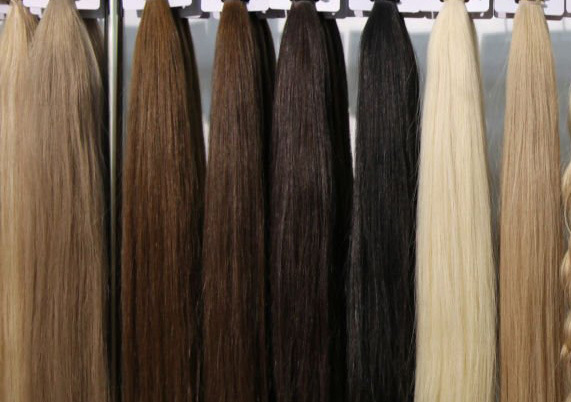Hair extensions have become increasingly popular in recent years, offering individuals the opportunity to change their hairstyle, add volume, or experiment with different looks. However, diving into the world of hair extensions can be overwhelming, with various attachment methods, types of hair, and maintenance requirements to consider. In this comprehensive guide, we'll explore everything you need to know about hair extensions, from choosing the right type to caring for them properly.
Understanding Hair Extensions: An Overview
Hair extensions are strands of hair that are attached to your natural hair to add length, volume, or color. They come in various forms, including clip-ins, tape-ins, fusion, weaves, and more. Each type offers its own benefits and considerations, making it essential to understand the differences before making a decision.
Types of Hair Extensions
- Clip-in Extensions: Ideal for temporary use, clip-in extensions are quick and easy to attach and remove. They come in various lengths and colors, allowing for versatility in styling.
- Tape-in Extensions: These extensions consist of small sections of hair attached to adhesive strips. They offer a natural look and last for several weeks with proper care.
- Fusion Extensions: Fusion extensions involve bonding individual strands of hair to your natural hair using heat or keratin glue. They provide a seamless blend and can last for months with regular maintenance.
- Weaves and Sew-in Extensions: Weaves involve braiding your natural hair and sewing extensions into the braids. They offer long-lasting results but require professional installation and regular maintenance.
Considerations Before Getting Hair Extensions
Before diving into the world of hair extensions, there are several factors to consider:
- Hair Type and Texture: Matching the extension hair to your natural hair type and texture is crucial for a seamless blend. Fine hair may require lighter extensions, while thicker hair can handle heavier extensions.
- Attachment Method: Different attachment methods work best for different hair types and lifestyles. Consult with a hair extension expert to determine the most suitable option for you.
- Quality of Hair: Not all hair extensions are created equal. Investing in high-quality, human hair extensions will ensure a natural look and long-lasting results.
Choosing the Right Hair Extensions
When selecting hair extensions, it's essential to consider your hair goals, lifestyle, and budget. Here are some tips for choosing the right extensions for you:
Consultation with a Hair Extension Expert
Before getting hair extensions, schedule a consultation with a reputable hair extension expert. They will assess your hair type, discuss your desired look, and recommend the best extension options for you.
Quality Over Price
While it may be tempting to opt for cheaper hair extensions, investing in quality extensions will yield better results in the long run. High-quality extensions will blend seamlessly with your natural hair and last longer, saving you time and money on maintenance.
Match Your Hair Color and Texture

Choose extensions that closely match your natural hair color and texture for a seamless blend. If necessary, consider getting custom-colored extensions to achieve the perfect match.
Consider Your Lifestyle
Consider your lifestyle when choosing hair extensions. If you lead an active lifestyle or frequently style your hair, opt for durable extensions that can withstand heat styling and daily wear.
Caring for Your Hair Extensions
Proper maintenance is essential for preserving the quality and lifespan of your hair extensions. Follow these tips to care for your extensions:
Washing and Conditioning
Use a sulfate-free shampoo and conditioner specifically formulated for hair extensions to prevent damage and tangling. Gently wash and condition your extensions, avoiding harsh rubbing or twisting.
Avoiding Heat Damage
Minimize heat styling to prevent damage to your extensions. When heat styling is necessary, use a heat protectant spray and a low heat setting to avoid drying out the hair.
Brushing and Detangling
Use a wide-tooth comb or a specialized hair extension brush to gently detangle your extensions. Start from the bottom and work your way up to avoid pulling or tugging on the hair.
Regular Maintenance
Schedule regular maintenance appointments with your hair extension expert to ensure that your extensions stay in optimal condition. This may include tightening bonds, repositioning tapes, or replacing worn-out extensions.
Potential Risks and Considerations
While hair extensions can enhance your appearance, there are some potential risks and considerations to keep in mind:
- Allergic Reactions: Some individuals may experience allergic reactions to the adhesives or chemicals used in certain attachment methods. Always perform a patch test before getting extensions.
- Hair Damage: Improper attachment or removal of extensions can cause damage to your natural hair, including breakage, thinning, or traction alopecia. It's essential to follow proper installation and maintenance procedures to minimize the risk of damage.
- Maintenance Costs: Hair extensions require regular maintenance appointments, which can add up over time. Factor in the cost of maintenance when budgeting for your hair extension project.
Hair extensions offer a versatile and convenient way to change your hairstyle and enhance your natural beauty. By understanding the different types of extensions, choosing the right option for your hair type and lifestyle, and following proper maintenance techniques, you can achieve stunning results that look and feel natural. Remember to consult with a reputable hair extension expert and prioritize quality when selecting extensions. With the right care and attention, your hair extensions can become a valuable addition to your beauty routine.
